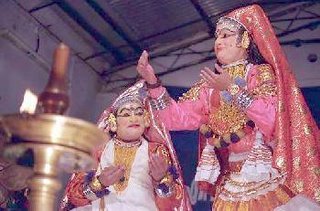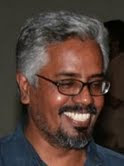celebrating a kathakali actor

MINUKKU – Celebrating The Actor
When one thinks of documentaries, one thinks of issues and problems,or of eulogistic narration and information packages. Issue orpersonality-driven, it has seldom been explored as an art in itself inKerala. Mostly, it is considered as a stop-over between or before onemoves to one's real calling and destination in cinema - full lengthfeature films. As a result, documentaries have not been approached asa medium of self expression or as an art form in its own right. But MR Rajan is a rare exception in Indian cinema. In his career spanningtwo decades, he has been exploring this medium to bring to life manyfacets of our life, art, culture and history.
His new film 'Minukku'is on the legendary Kathakali actor Kottakkal Sivaraman who hasenthralled generations of kathakali viewers. Known for his alluringenactment of female characters, it was he who gave the female roles inkathakali the charm and depth that it has now. Minukku is Rajan'slatest film in his series on actors and artists. His earlier filmswere on Ammanur Madhava Chakyar, Keezhpadam Kumaran Nair, Premji, MRBhattathiripad, and T P Gopalan.At one level, this film is an interface between the kathakali actor onthe one hand, and a film actor (Nedumudi Venu) and an artist (E PUnni) on the other. Nedumudi, an ardent admirer of Sivaraman, followsthe latter's life and experiences in the film, while Unni's sketchescaptures the sculptural beauty of Sivaraman's face, gestures andexpressions. This interface is also one between different art forms.Art forms like drawing and cinema, in a way, are very much unlike aperforming art like Kathakali, which is a temporal art, one that comesalive and illuminates our imagination only while it is beingperformed. On the other hand, both cinema and drawing, resist thisevanescence, remaining behind, recorded, for generations to come to appreciate and enjoy it. While the documentary itself is an attempt atdocumenting Sivaraman, the actor par excellence, the same process isunderlined by the presence of or dialogue with the other two artforms.This hour-long documentary weaves together the first person account ofSivaraman, who reminisces about his childhood, gurus, early life, andwaxes eloquent about his 'star hero' Kalamandalam Gopi, along withexcerpts from his performances in various roles, as Damayanti,Poothana, Panchali, etc. Interspersed with these are the sketches ofUnni and the exchanged between the film actor and kathakali actor.The film is done on cinemascope (impressive camera work by Venu) whichevocatively captures the epic scale of kathakali performances and thelandscape of the art, at the same time liberating the documentaryformat from its conventional association with poverty in productionqualities. The impact of this format is evident in the brilliantopening and final shots of the film.
The film opens with a long shotof a hill, against the background of the blue expanse of the sky, uponwhich the kombu-artists make their clarion-call as it were. This shotis followed by that of the kathakali scene, the court of Duryodhana,where the Kauravas and Pandavas are arrayed across the screen withPanchali in the middle pleading with them. Similarly in the final shotwe find Sivaraman in the form of Rambha, the enchantress, against thebluish landscape of Valluvanad..Minukku thus liberates documentary from its narrow visions andcanvases. It is both an ode to one of the all time greats ofKathakali, as well as a tribute of one art form (cinema) to another(kathakali).
Labels: classical arts and cinema, kathakali


0 Comments:
Post a Comment
Subscribe to Post Comments [Atom]
<< Home